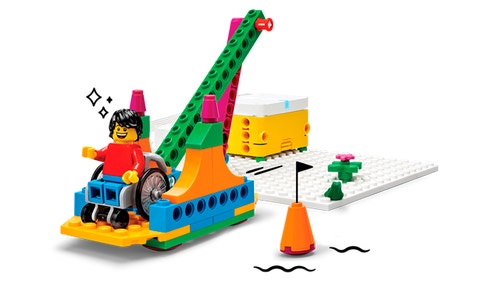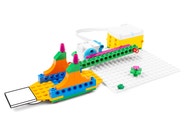River Ferry
Help Daniel reach the Spike Tower by programming the river ferry to move!

Prepare
- Review the River Ferry lesson in the LEGO® Education SPIKE™ App.
- If you feel that it would be beneficial, pre-teach these related vocabulary words: improve, modify, program, sequence, test and upgrade.
- Consider the abilities and backgrounds of all your pupils. Differentiate the lesson to make it accessible to everyone. Please refer to the Differentiation section below for suggestions on how to do this.
- If time permits, plan and facilitate the maths extension. Please refer to the Extension section below for further information.
Engage
(Whole Class, 5 Minutes)
- Facilitate a quick discussion about creating a sequence in order to complete an activity.
- Talk with your pupils about a situation in which they had to follow a sequence in order to reach a destination, like their classroom or a playground.
- Ask questions like these: When you want to go from one classroom to another, how do you get there? How do you know how to get there?
- Introduce your pupils to the story’s main characters and the first challenge: sending the river ferry to the Spike Tower.
- Distribute a brick set and a device to each group.
Explore
(Small Groups, 30 Minutes)
- Have your pupils use the LEGO® Education SPIKE™ App to guide them through their first challenge:
- Create and test the program that sends the river ferry to the Spike Tower.
- Have your pupils iterate and test their models to complete the next two challenges in the app:
- Modify the program to improve the river ferry ride.
- Upgrade the river ferry for Daniel’s next journey.
- You can find coding and building help in the Tips section below.
Explain
(Whole Class, 5 Minutes)
- Gather your pupils together to reflect on their completed challenges.
- Ask questions like these: What steps did you follow to send the river ferry to Spike Tower? What did you modify in order to improve the river ferry ride?
Elaborate
(Whole Class, 5 Minutes)
- Prompt your pupils to discuss and reflect on the process of creating a sequence to solve a problem.
- Ask questions like these: Why does it help to break a problem down into smaller parts when you are trying to solve it? How can you use these smaller parts to create a sequence?
- Have your pupils tidy up their workstations.
Evaluate
(Ongoing Throughout the Lesson)
- Ask guiding questions to encourage your pupils to ‘think aloud’ and explain their thought processes and reasoning in the decisions they have made while building and programming their models.
Observation Checklist
- Measure your pupils’ proficiency in developing a sequence to solve a problem.
- Establish a scale that suits your needs. For example:
- Requires additional support
- Can work independently
- Can teach others
Self-Assessment
Have each pupil choose the brick that they feel best represents their performance.
- Yellow: I think that I can develop a sequence to solve a problem.
- Blue: I can develop a sequence to solve a problem.
- Green: I can develop a sequence to solve a problem, and I can also help a friend to do it.
Peer Feedback
- In their small groups, have your pupils discuss their experiences working together.
- Encourage them to use statements like these:
- I liked it when you…
- I would like to hear more about how you…
Tips
Coding Tips
- After your pupils have completed their first challenge, they will be provided with a map.
- Using the map, your pupils can experiment with the available Coding Blocks to modify their programs to follow the route for the trip.




Model Tip
- After your pupils have completed their second challenge, they will be provided with three Inspiration Images and an open-ended prompt, which will help them to improve their models.
- The Inspiration Images are meant to help spark their imaginations as they experiment and change their models.




There are no specific building instructions for this challenge.
Differentiation
Simplify this lesson by:
- Reading the River Ferry story and instructions from the
LEGO® Education SPIKE™ App aloud to your pupils - Selecting one Inspiration Image to help your pupils to change their models
Increase the difficulty by:
- Exploring new and different coding blocks within the program
- Adding the Light to the river ferry
Extension
- Ask your pupils to create a timetable for the river ferry, including departure and arrival times, and travel time. Have them use their timetables to talk about when to take the river ferry.
If facilitated, this will extend beyond the 45-minute lesson.
Teacher Support
The pupils will:
- Develop a sequence to solve a problem
- Decompose problems into smaller parts
- Recount an experience using relevant facts and descriptive details
(one for every two pupils)
- LEGO® Education SPIKE™ Essential Set
- Device with the LEGO® Education SPIKE™ App installed
Design and Technologies
ACTDEK013
Investigate the suitability of materials, systems, components, tools, and equipment for a range of purposes .
Digital Technologies
ACTDIP009
Collect, access and present different types of data using simple software to create information and solve problems.
English Language
ACELA1475
Understand that languages have different written and visual communication systems, different oral traditions and different ways of constructing meaning.




